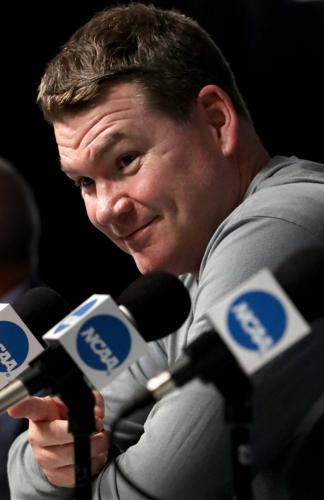SAN DIEGO — The Phoenix kid who ran around in Arizona basketball practice gear at age 8 or 9, right around the time the Wildcats were returning to the nation’s elite, took a look around before his first NCAA Tournament game to reflect briefly.
Maybe there were other young fans doing the same thing Friday as Dalen Terry once did, before top-seeded Arizona beat Wright State 87-70 in the first round of the NCAA Tournament to reach a second-round game with TCU on Sunday.
“Before they announced the starting lineup, I felt a little bit of chills,” Terry said Saturday, during official pregame podium interviews outside Viejas Arena. “I was like, dang, this is what I’ve been waiting for all my life. I’ve been watching March Madness since I was in grade school, since I can remember.
“It was just a good feeling to be out there and being part of it, knowing that there’s a little kid that was in my spot before watching me now.”
Terry added to the moment by collecting 16 points, seven rebounds and four assists against the Raiders while helping the Wildcats get by again without injured point guard Kerr Kriisa. It was all good for Terry and the Wildcats.
But there is a lot more urgency and significance now.
Regardless of Kriisa’s status — UA coach Tommy Lloyd said again Saturday only that his starting point guard is “day to day” with a sprained ankle he suffered on March 10 — Terry is expected again to take some of the ballhandling duties and provide confidence against a team that is programmed to destroy exactly those things.
Ninth-seeded TCU, which improved to 21-12 after bouncing Seton Hall 69-42 in a first-round tournament game later Friday, allowed the Pirates to shoot just 28.8% and turned 13 turnovers into 15 points.
“We’ve been preaching what we could become and what we have been defensively at times,” TCU coach Jamie Dixon said after Friday’s game. “I think today you saw it for 40 minutes. I thought it was a special effort, a special performance. That’s the team we can become.”
Basically, TCU is of those almost stereotypical Big 12 defensive smash-mouth teams, doing so with an aggressive, help-oriented style known as “no middle” that is designed to keep the ball on the perimeter.
The Horned Frogs rank No. 15 in defensive efficiency as a result.
“They’re great defensively,” Lloyd said. “Seems like that whole Big 12 — and Tennessee — have tilted towards that no-middle, try-to-keep-you-on-the-side defense. And they’re good at it. And on top of that they’re extremely physical. They’re a great rebounding team. That’s always been a trademark of Jamie’s teams.”
UA associate head coach Jack Murphy said Stanford probably compares most to TCU defensively but both he and Lloyd noted that nobody really ran the same scheme in the Pac-12.
Tennessee, meanwhile, jumped on UA to take a 13-point halftime lead on Dec. 22 and prompted the Wildcats to take nearly half of their field goals from 3-point range in what became a 77-73 loss for UA.
Arizona also had 17 turnovers in that game that turned into 16 points for the Volunteers.
“No one’s playing as committed to the no-middle stuff in the Pac-12 as these guys are,” Lloyd said of TCU. “The first thing you’ve got to be strong with the ball. You’ve got to play with a thrust, play with our normal pace and movement. Then you’ve got to trust your fundamentals. You’ve got to lock in, play with your feet on the ground, mix in some back cuts, pass fake. I tell our guys, play good basketball. That’s what we’ve got to do.”
That’s where Terry comes in. All of those things he can do well, potentially giving the Wildcats the sort of aggression Lloyd has been asking for all week, instead of being the tentative favorite that gets into trouble trying not to lose.
Whatever happens, Terry pledged to keep staying aggressive.
“We definitely have to be in attack mode,” he said. “It doesn’t really matter what team we’re (playing), Tommy was making that a point across the board that we’ve just got to be in attack mode. This is a tournament game. This is March. Anybody — it’s March. Anything happens. I mean, we’ve got to come out throwing punches.”
Honored as a “glue guy” entering the Pac-12 tournament last week, by analytic and media alike, Terry has since averaged 14.3 points and 4.3 assists in the three games that Kriisa has been sidelined, sharing the point guard role with senior Justin Kier.
“He’s really come a long way as a player this year,” Lloyd said. “He’s really developed. With Kerr not having played, maybe we need a little bit more of a scoring punch out of him and he’s been opportunistic.”
“Dalen is a good, developing shooter. If teams are going to play off him, I’m comfortable with him taking those wide-open 3s. And he steps up and makes them in critical times. They’ve been a catalyst for us these last couple of games.”
If TCU’s defense is successful in keeping the Wildcats out of the middle, Terry may have to be shooting more often from the perimeter, too. So might Kier, Bennedict Mathurin and sophomore guard Pelle Larsson.
Maybe that’s a good thing for the Wildcats. TCU’s style means there will be no time for pause or reflection. The Wildcats have to attack.
If they want to keep playing, that is.
“It’s a great thing,” Lloyd said about the physical battle ahead. “That’s what you’re going to have to do to keep advancing in this tournament. That’s what we’ve been building for all year. I’m excited to see how it looks tomorrow.”





